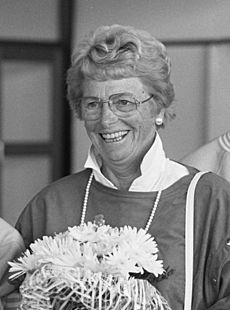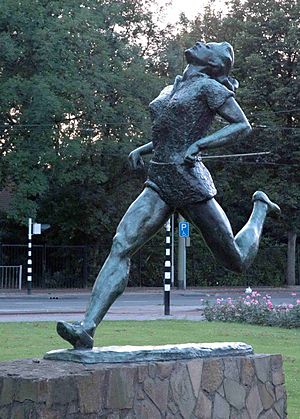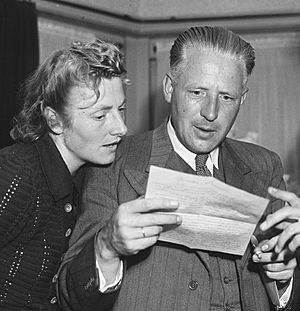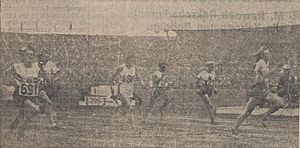Fanny Blankers-Koen facts for kids

Fanny Blankers-Koen in 1988
|
|||||||||||||||||||||||||||||||||||||||||||||||
Quick facts for kids Personal information |
|||||||||||||||||||||||||||||||||||||||||||||||
|---|---|---|---|---|---|---|---|---|---|---|---|---|---|---|---|---|---|---|---|---|---|---|---|---|---|---|---|---|---|---|---|---|---|---|---|---|---|---|---|---|---|---|---|---|---|---|---|
| Born | 26 April 1918 Lage Vuursche, Netherlands |
||||||||||||||||||||||||||||||||||||||||||||||
| Died | 25 January 2004 (aged 85) Hoofddorp, Netherlands |
||||||||||||||||||||||||||||||||||||||||||||||
| Height | 1.75 m (5 ft 9 in) | ||||||||||||||||||||||||||||||||||||||||||||||
| Weight | 63 kg (139 lb) | ||||||||||||||||||||||||||||||||||||||||||||||
| Sport | |||||||||||||||||||||||||||||||||||||||||||||||
| Sport | Athletics | ||||||||||||||||||||||||||||||||||||||||||||||
| Club | Sagitta, Amsterdam; ADA, Amsterdam | ||||||||||||||||||||||||||||||||||||||||||||||
|
Medal record
|
|||||||||||||||||||||||||||||||||||||||||||||||
Fanny Blankers-Koen was an amazing Dutch athlete. She is best known for winning four gold medals at the 1948 Summer Olympics in London. At 30 years old, she was a mother of two children. This earned her the famous nickname "the Flying Housewife". She was the most successful athlete at those Olympic Games.
Fanny started competing in athletics in 1935. A year later, she took part in the 1936 Summer Olympics. Even though World War II stopped many international sports events, Fanny set several world records during that time. She excelled in many different events, like the long jump, high jump, and sprint and hurdling races. Besides her four Olympic golds, she won five European titles and 58 Dutch championships. She also set or tied 12 world records. Her last world record was in the pentathlon in 1951, when she was 33. She stopped competing in 1955. Later, she became the captain of the Dutch women's track and field team. In 1999, the International Association of Athletics Federations (IAAF) named her the "Female Athlete of the Century". Her Olympic wins helped show everyone that age and being a mother were not barriers to success in women's sports.
Contents
Early Life and First Olympics
Fanny Koen was born on April 26, 1918, in Lage Vuursche, Netherlands. Her father was a government official who also competed in sports. Fanny loved many sports as a teenager, including tennis, swimming, gymnastics, and running. She was a natural athlete, standing tall at 1.75 meters (5 feet 9 inches).
She couldn't decide which sport to focus on. A swimming coach suggested she try running. He said there were already many great swimmers in the Netherlands. He thought she would have a better chance to reach the Olympics in track events.
Fanny first competed in athletics in 1935, when she was 17. Her first race was tough, but in her third race, she set a national record in the 800-meter event. Soon, Fanny joined the Dutch team as a sprinter. The 800-meter race was thought to be too hard for women back then.
In 1936, her coach and future husband, Jan Blankers, encouraged her to try out for the 1936 Summer Olympics in Berlin. Jan was a former Olympic triple-jumper. At 18, Fanny was chosen to compete in the high jump and the 4 × 100-meter relay.
At the Berlin Olympics, Fanny finished fifth in the high jump. The Dutch relay team also came in fifth. She also got an autograph from the famous American athlete Jesse Owens. This became her most prized possession.
Fanny kept getting better. In 1938, she set her first world record in the 100 yards. She also won her first international medals at the European Championships in Vienna. She earned bronze medals in both the 100 and 200-meter races. Many people, including Fanny herself, expected her to do very well at the 1940 Summer Olympics in Helsinki. However, World War II started, and the Olympics were canceled.
World War II and Motherhood
Just before the war, Fanny got engaged. On August 29, 1940, she married Jan Blankers and changed her name to Blankers-Koen. Jan was 15 years older than her. He was a sports journalist and coached the Dutch women's athletics team. At first, he didn't think women should compete in sports. But his mind changed after he fell in love with Fanny.
When Fanny gave birth to her first child, Jan Junior, in 1942, many people thought her sports career was over. It was very unusual for married women, especially mothers, to be top athletes back then. But Fanny started training again just weeks after her son was born.
During the war, sports competitions continued in German-occupied Holland. Fanny Blankers-Koen set six new world records between 1942 and 1944. In 1942, she improved the world record in the 80-meter hurdles. The next year, she broke the high jump record by a big 5 centimeters, reaching 1.71 meters. She also tied the 100-meter world record. She ended that year with a new world record in the long jump, reaching 6.25 meters. This record lasted until 1954.
Life was hard during the war, especially getting enough food for an athlete. But Fanny still managed to break the 100-yard world record in May 1944. She also helped her relay team break the 4 × 110-yard world record. Months later, her team broke the 4 × 200-meter record. In a brave act, the women wore outfits with national symbols while setting the record.
The winter of 1944–45 was very tough, known as the Hunger Winter. There was a severe lack of food. Fanny gave birth to her daughter, Fanneke, in 1945. This time, she took seven months off from sports and did only light training.
"The Flying Housewife" at the 1948 Olympics

The first big international event after the war was the 1946 European Athletics Championships in Oslo. Fanny had some trouble there. In the 100-meter semi-finals, she fell and didn't make it to the final. She finished fourth in the high jump. But on the second day, she won the 80-meter hurdles and helped the Dutch relay team win the 4 × 100-meter race.
As the best female athlete in the Netherlands, Fanny was sure to be on the Dutch team for the 1948 Summer Olympics in London. She decided to focus on four events: the 100 meters, 200 meters, 80-meter hurdles, and the 4 × 100-meter relay. Even though she was in great shape, some journalists thought she was too old at 30 to be an athlete. Many people in the Netherlands also thought she should stay home with her children instead of competing.
Her first event was the 100 meters. She easily made it to the semi-finals and set the fastest time. The final was held on a muddy track in the rain. Fanny sped to the finish line in 11.9 seconds, easily winning the gold medal. She became the first Dutch athlete to win an Olympic title in athletics.
Next was the 80-meter hurdles. Her main rival was Maureen Gardner from Britain. Both athletes made it to the final. Fanny had a bad start, thinking there was a false start. She quickly caught up, and it was a very close race. Both finished almost at the same time. When the British national anthem played, Fanny thought she had lost. But the anthem was for the British royal family entering the stadium. A close look at the finish photo showed Fanny had won!
Despite her wins, Fanny almost didn't start the 200-meter semi-finals. She felt very homesick. After talking with her husband, she decided to run. She easily qualified for the final. The final was also in the rain. Fanny won the first-ever Olympic 200-meter race for women in 24.4 seconds. She was seven-tenths of a second ahead of the second-place runner, which is still the biggest winning margin in an Olympic 200-meter final.
The 4 × 100-meter relay final was on the last day. The Dutch team made it to the final. Just before the race, Fanny was missing! She had gone to buy a raincoat. She arrived just in time. As the last runner, she took the baton in third place, about five meters behind the Australian and Canadian runners. Even with a careful hand-off, she caught up and crossed the finish line a tenth of a second before the Australian team.
Fanny Blankers-Koen won four gold medals out of the nine women's events at the 1948 Olympics. She competed in eleven races over eight days. She was the first woman to win four Olympic gold medals in a single Olympics. The international press called her "the flying housewife" and "amazing Fanny". When she returned to Amsterdam, a huge crowd welcomed her. She rode through the city, pulled by four white horses. She received many gifts, including a new bicycle from the city. Queen Juliana made her a knight of the Order of Orange Nassau.
After London and Later Life
After her incredible success, Fanny Blankers-Koen became famous worldwide. She received many offers for ads and public appearances. But because of strict rules about amateur athletes at the time, she had to turn most of them down. In 1949, she traveled to Australia and the United States to promote women's athletics.
In 1950, Fanny almost repeated her Olympic success at the European Championships in Brussels. She won gold medals in the 100 meters, 200 meters, and 80-meter hurdles. She just missed a fourth win in the relay, which the British team won.
At age 34, she competed in her third Olympics in Helsinki in 1952. She was in good shape, but a skin infection bothered her. She made it to the 100-meter semi-finals but decided not to run to save energy for the hurdles. She reached the hurdles final, but after hitting the second hurdle, she stopped the race. This was her last major competition. On August 7, 1955, Fanny Blankers-Koen won her last national title in the shot put, her 58th Dutch title.
After her sports career, Fanny Blankers-Koen became the team leader for the Dutch athletics team. She held this role from the 1958 European Athletics Championships until the 1968 Summer Olympics.
In 1977, her husband Jan passed away. A few years later, she moved back to her old hometown of Hoofddorp. In 1981, the Fanny Blankers-Koen Games, an international athletics event, were started in Hengelo. These games are still held every year.
Fanny Blankers-Koen had one more moment of fame in 1999. At a special event in Monaco, the International Association of Athletics Federations (IAAF) named her the "Female Athlete of the Century". She was very surprised and asked, "You mean it is me who has won?"
In her final years, Fanny Blankers-Koen suffered from Alzheimer's disease and lived in a nursing home. She was also deaf. She passed away at age 85 on January 25, 2004.
A book about Fanny Blankers-Koen was published in 2003. It showed a different side of her, as a woman who was very driven to win. During her famous years, the media often showed her as the perfect mother who was modest about her achievements.
Fanny Blankers-Koen Carrièreprijs
The Fanny Blankers-Koen Carrièreprijs is an award given by the NOC*NSF to honor great Dutch sportspeople. It was first given out on December 9, 2005. Five people received the award that year. Since then, one person receives the award each year.
Awards and Tributes
- Dutch Athlete of the Year: 1937, 1940, 1943
- Associated Press Female Athlete of the Year: 1948
- Knight of the Order of Orange-Nassau: 1949
- Medal of the NOC*NSP: 1949
- Royal Dutch Athletics Federation honorary member: 1949
- IAAF Female Athlete of the 20th Century: 1999
- IAAF Hall of Fame: 2012
Fanny Blankers-Koen was included in a book called 1001 Vrouwen uit de Nederlandse geschiedenis (1001 Women from Dutch History). In a 2004 national poll for "The Greatest Netherlander," she ranked 29th. She was the third highest sportsperson and the seventh highest woman on the list.
Two public statues of her have been built in the Netherlands. The first was placed in Rotterdam in 1954. The second was placed in Hengelo in 2007. Also in 2007, a plaque was put up in Amsterdam saying, "Fanny Blankers-Koen trained here."
Several places are named after her, including Blankers-Koen Park in Australia. A fire station in Amsterdam and a sports hall in Hoofddorp are also named in her honor.
Fanny Blankers-Koen was honored with a Google Doodle on April 26, 2018. This was on what would have been her 100th birthday.
Images for kids
See also
 In Spanish: Fanny Blankers-Koen para niños
In Spanish: Fanny Blankers-Koen para niños





